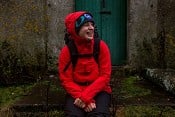In reply to Abu777:
I went to the Hurrungane in Norway a few years ago which I think would fit your requirements.
It's mostly Alpine rock routes with glacier approaches or snow plods rather than technical snow and ice climbs but then again, there are fewer of those in Alps with every passing year.
Whilst the mountains aren't as big as the Alps it does have some advantages. There are no altitude issues (the highest mountain is only 2400m), it's not really busy, the chance of an electrical storm is way smaller and you won't get benighted because in summer it doesn't really go dark. Also, you don't get the same massive temperature variation between day and night which combined with the absence of darkness means you don't need to have stupidly early Alpine starts.
The only English language guidebook I know of is this one, though there may be others
https://www.scandinavianmountains.com/books/hurrungane.htm
It's a bit of a wierd half guide/half coffee-table book and the author uses his own made up grading system but it's a good place to start.
If you google Hurrungane I'm sure you'll find more info and there was an article about it here on UKC which you could search for.
There's also some Alpine climbing in Iceland around the edge of the Vatnajokull icecap though I don't think there's a guidebook so you'll have to do some research. Googling for climbing in Iceland mostly brings up rock and water ice routes so specify Alpinism and you should find something. That said, we just followed our noses up Hvannadalshnúkur (the highest summit) when we were there.
Iceland has the same benefits as the Hurrungane.









